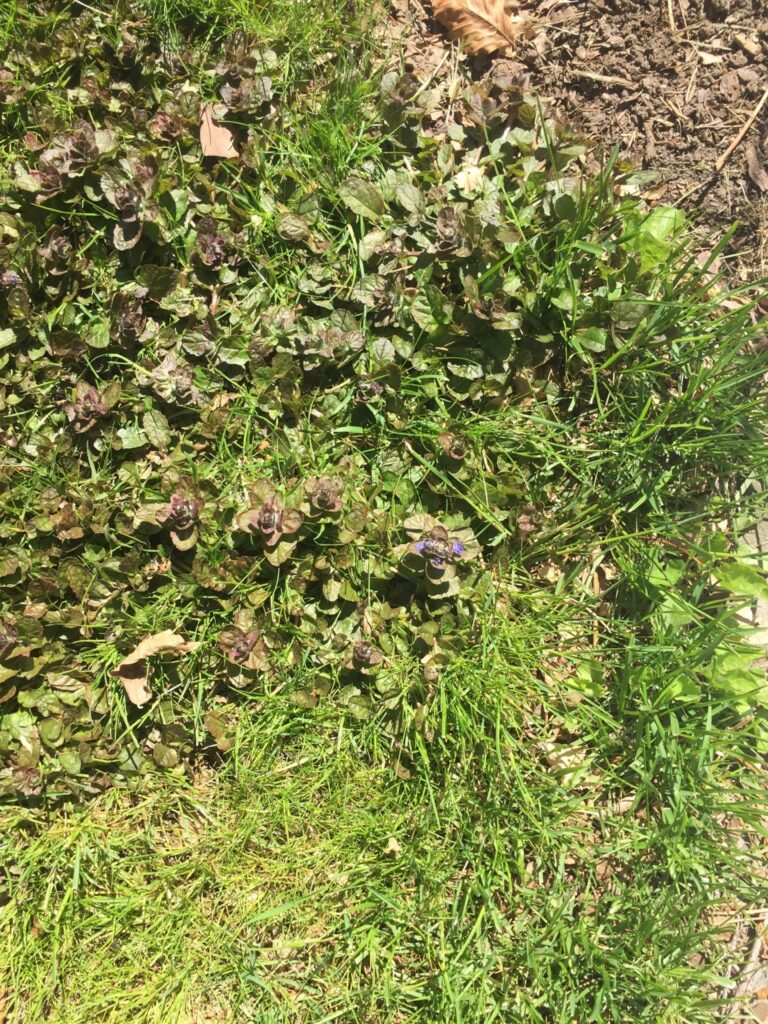
Hello. First i would like to thank the master gardener who answered my question about garlic mustard. Very helpful
My next question is about this plant growing in my lawn in Mississauga. I will attach a photo. It looks like Ajuga and is quite persistent. Any suggestions on how to get rid besides the obvious – elbow grease would be appreciated
Cheers
Mary Greer
Thank you for contacting the Toronto Master Gardeners.
The plant in question is indeed bugleweed (Ajuga reptans). Because ajuga naturalizes easily, spreading by stolons, or horizontal stems that creep along the ground, you’ll want to think about where you plant it. This member of the mint family spreads fast and can become invasive.
The key to removing ajuga is patience. The best way to remove this plant is hand pulling. Watering the area well the day before makes it easier to pull, another tip is loosening the surrounding area with a spade or garden fork. Take your time when removing the roots ensuring that the majority of the root has been removed because even if a small piece is left in the soil can take root and spread. This approach will take time but if you are persistent you will eventually gain the upper hand.
Constantly mowing down the plants eliminating the food producing organs will slowly deplete the plants energy reserves and the roots will eventually die. Also making sure to not let the plant set seed will reduce the number of plantlets sprouting up.
Once you have removed the ajuga, your goal will be to prevent it from coming back by having a thick and healthy lawn with no room for competitors. The Government of Canada has a good section on pesticide free lawn maintenance which can be viewed here: https://www.canada.ca/en/health-canada/services/home-garden-safety/how-have-healthy-lawn.html The key seven steps recommended are as follows:
- Mow high — Cut your grass to a height of 6 to 8 centimetres (2.5 to 3 inches). This height (instead of cutting shorter) will promote growth, prevent weeds, and discourage insect pests.
- Water deeply — Water your lawn deeply (but not too often) to promote the growth of deep roots. Apply about 2.5 centimetres (1 inch) of water, only when needed (usually no more than once a week). Place a small pet food or tuna can on the lawn to help you measure how much water has been applied. Stop watering when the can is full. Too much water starves the soil of oxygen and invites disease.
- Feed — Feed your lawn with compost. Let grass clippings stay on your lawn to provide nutrients.
- Aerate — Aerate compacted soil, ideally in the fall. This helps water, air, and nutrients reach plant roots more easily.
- Overseed — Sow new seed over thinned areas, or choose other ground covers for tough spots.
- Replace — Replace grass with paving stones or mulch in heavy traffic areas.
- Check — Check your lawn often to detect pests and other problems early.
Although it is a lot of work, if you chip away at it during cooler parts of the day you can eradicate the ajuga.

